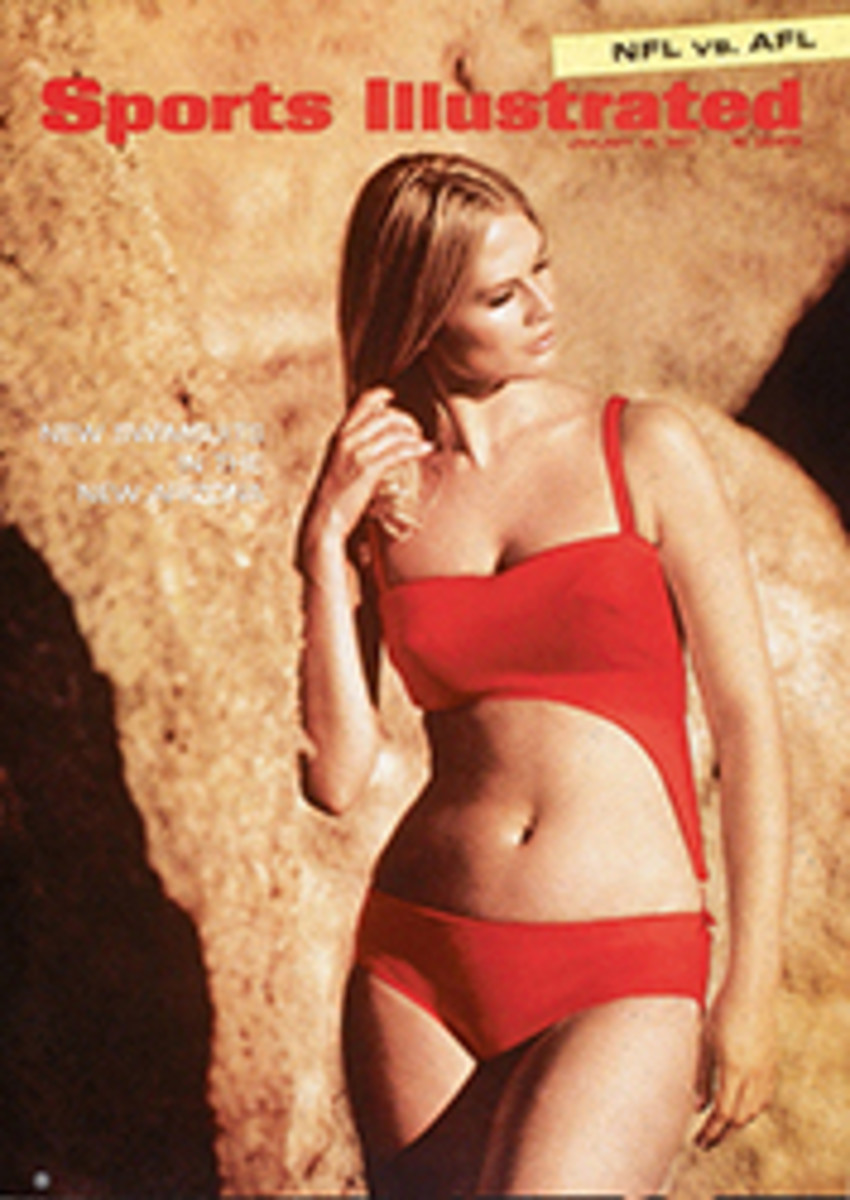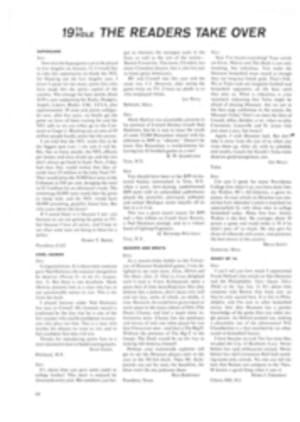
Hockey fans and skiers find Montreal a French and fetching winter festival
With its backdrop of volcanic rock hovering above the northern skyline, Montreal, the biggest French-speaking city outside Paris, provides a dramatic setting for sport. The people live up to the scene, for the passions aroused by sport are little short of volcanic. The Canadiens, who have won more Stanley Cups than any other team in the hockey circuit, are the principal preoccupation of many French-Canadians. These hockey fans consider summer just a pleasant interval until the serious business starts in the fall.
Don't worry about the "language barrier." Traffic signs, tourist information and almost everything else of importance are in both French and English. But the spirit of the city, like that of the entire province of Quebec, is French—more French than France, some think. French pride is higher than at any time since the British conquest in 1759. The province of six million or so has been passing through a very unquiet "quiet revolution" in which the French Fact, as it is called, has been paramount.
An inland seaport 1,000 miles from the sea, Montreal covers a considerable part of the largest of a group of islands at the confluence of the Ottawa and St. Lawrence rivers. Right now, Montreal's civic hopes are fixed on Expo 67, the world exposition that will open next April. The pavilions and exhibits of some 70 nations are rising on St. Helen's Island in mid-St. Lawrence.
St. Helen's Island is one of the city's oldest and most attractive parks. Here is a 300-year-old fort of massive stone where Chevalier de Lévis, holding out to the last, burned his flags before surrendering to the British. In World War II, Nazi prisoners were sometimes housed there. Now it is occupied by marines, in the uniform of the old French regime, who parade daily out-side the barracks.
Montreal has a population close to 1.5 million. Another million people live in the suburbs. The English population of about 250,000 is confined mainly to the west end and to such suburbs as Westmount, a city within the city.
The visitor will find many excellent French and Italian restaurants in Montreal, not all of them expensive. You can get a very good table d'hôte luncheon from $1.50 up and a highly acceptable dinner starting at $3. You can get the classic French cuisine retained by the larger hotels and restaurants, or national cuisines and a thousand specialties and exotic dishes. Dinner, with wine, need cost no more than $10 per person. Tucked away in a corner of old Montreal, Auberge le Vieux St. Gabriel prepares superlative French food. A dinner of coq au vin, with vintage wines, costs $16 per couple.
A seafood restaurant, Desjardins, one of the best in town, may run you up a sizable tab, but you will get a memorable meal. And diners who have tickets to the hockey game need not worry; the staff will get them there on time and free of charge.
Patrons of La Crêpe Bretonne are served paper-thin pancakes with 81 different fillings, a delicacy from Brittany that is the rage now in Montreal. Since hockey players have found tending bar nearly as profitable as slapping pucks into the net, there are a number of hangouts for the cognoscenti. At Toe Blake's tavern on St. Catherine, Blake, the coach of the Canadiens, shows up whenever the team is in town to dispense some of the famous Canadian ales along with inside information on pro hockey. Fans, players and coaches head here before and after games for T-bone steaks and arguments. Located across the street from Blake's is Pauze's Seafood Restaurant, where lobsters go for $5 a pound and oysters for $2 a dozen.
On the night of a big football game, the fans queue up in front of Joe's Steakhouse on Metcalfe—two minutes from McGill's Molson Stadium. For $2.35 you can tackle a steak big enough for an Alouette lineman. An extremely pleasant place is Altitude 737 at the top of the 42-story Place Ville Marie, at the dead center of the downtown area, with a breathtaking view of the city. All of these restaurants are highly touted and excellent, but for an unusual (and indigenous) taste experience try the Canadian pea soup at Mother Martin's. "Insecurity to a Mont-realer," as Ma√Ætre d'H√¥tel Guy Lapierre said recently, "is finding himself more than 22 feet from a place to eat."
Montreal is easily reached from the U.S. by highway. Most Americans cross either by the giant Jacques Cartier Bridge leading directly into town or by the new Champlain span to the west, downriver. Both routes arch over the St. Lawrence Seaway. It is also relatively simple to get around in the city, which is defined by three main streets: Sherbrooke, St. Catherine—the street of shops—and Dorchester Boulevard. It is bisected north and south by Park Avenue, which roughly divides the east and west areas. Most of the three million visitors a year operate within a square-mile area, of which the towering Place Ville Marie may be taken as the focal point.
As for sport, Montreal has practically everything. Soccer, brought in since the war by the Germans and Italians, is starting to challenge North American football. There are two professional football teams—the Alouettes of the Eastern Conference of the Canadian Football League and the Beavers of the Continental Football League. Lacrosse, borrowed from the Indians, is making a big comeback as a specifically Quebec pastime, and there is good horse racing at the Blue Bonnets and Richelieu tracks. For the golfer, numerous courses are available, and yachting is a big sport at Lakes St. Louis and St. Francis west of the city.
For fishing, you can go to all points of the compass and do well. South is Lake Memphremagog, a body of water 30 miles long stocked with rainbow and brown trout, landlocked salmon and black bass. To the northeast the most interesting route for the speckled-trout enthusiast is Route 43 in the Laurentian Mountains. The end of the trail for the ardent angler is famous Kanamouche Lodge, with its 30 or more wilderness lakes that offer fabulous trout fishing. Walleyes, bass and giant northern pike can be caught around St. Michel des Saints.
Straight north, along the auto route leading to Ste. Agathe—an hour's drive—you begin reaching additional good fishing country that gets better as you go on to Mont Laurier. Or, best of all, to the Northwest are the wilds of La Vérendrye Park. In the fall there is good deer and moose hunting in the Laurentian region.
But winter is the big time in Montreal. In winter you can always tell when Friday comes. Many office workers load their skis on top of their cars when they go to work. By four in the afternoon the big weekend exodus begins. The auto route north to Ste. Agathe and beyond is the access to a succession of ski runs, large and small, beginning 30 miles from Montreal and extending to Mont Tremblant, a two-hour drive.
Skiers from Toronto and the United States have been coming to the Laurentians now for years. Some 70,000 skiers can hit the slopes for a weekend, and yet few runs are really crowded. It was in the Laurentians that the first rope tow in the world was set up by Alec Foster in 1932. To this day, Foster runs a ski resort just outside Ste. Agathe.
Louis Cochand, former president of the Laurentian Resort Association, says that the greatest concentration of deluxe hotel and motel accommodations in North America is now found in the 40-square-mile ski area to Montreal's north.
But you don't have to go outside Montreal to ski. The interior slopes of Mount Royal swarm with skiers on a winter afternoon or evening, while below them on frozen Beaver Lake old-style skating is in full swing.
Quebec, as the license plates proclaim, is La Belle Province. Montreal, as the French newspaper Le Devoir puts it, is la ville dynamique. They say good Montrealers go to Florida when they retire. In actual fact, few Montrealers ever want to live anywhere but in Montreal.

